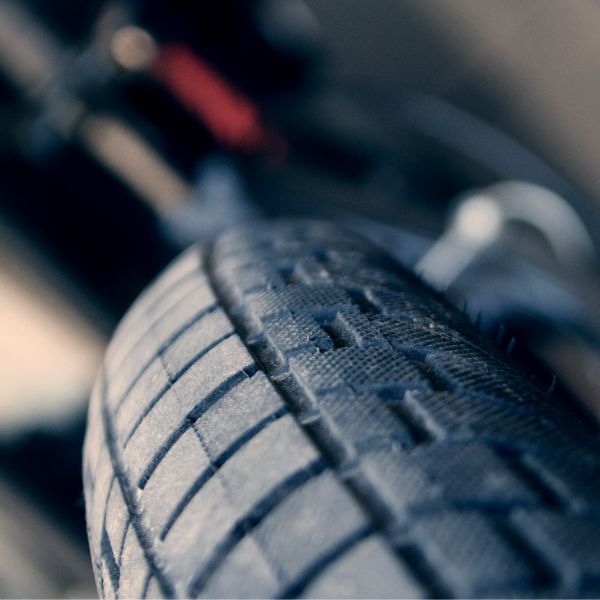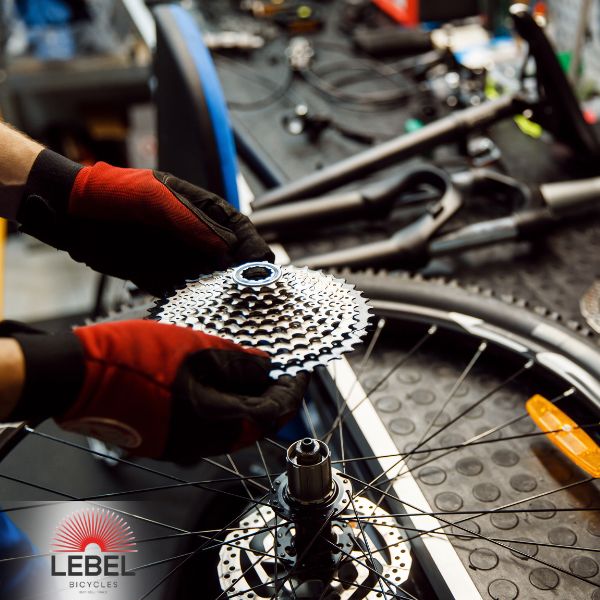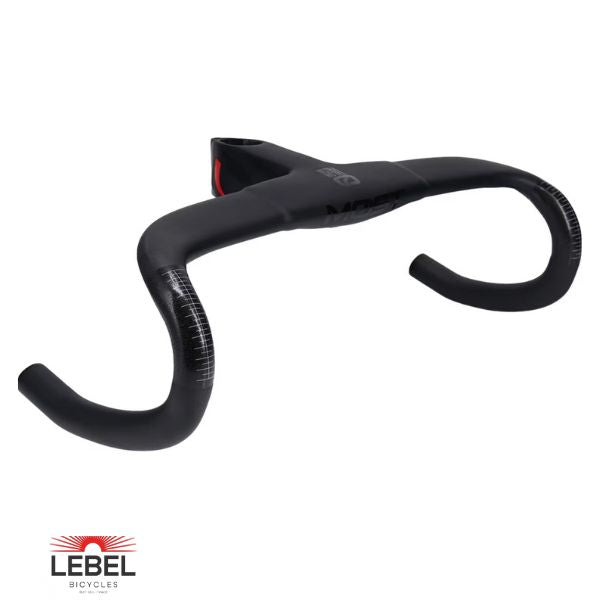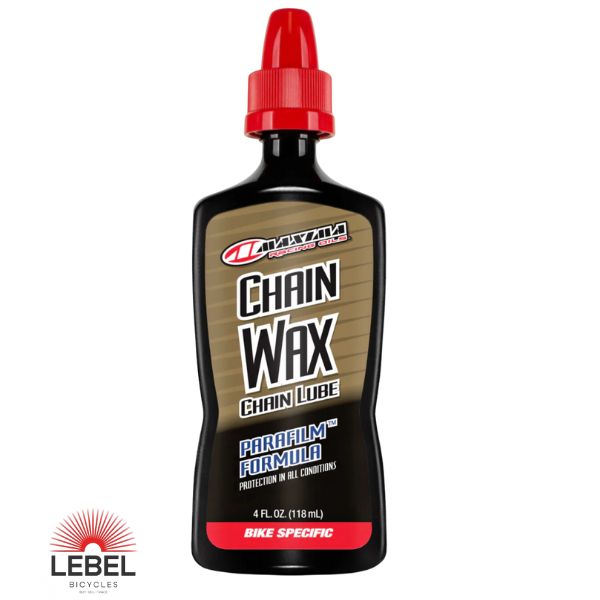Upgrading your bike increases your bike’s performance and speed, helps achieve greater comfort, and better handle terrain with increased control. Bike upgrades add more joy to your riding experience and increase your bike’s durability and overall safety. Upgrading your bike means replacing some of its components, getting accessories, and in some cases even replacing your old bike with a new one (or a used one of a better version). Some upgrades can be expensive, others are more affordable
Some examples of popular bike upgrades include:
- Tires: Upgrading tires impacts rolling resistance, grip, puncture protection, and comfort. Choose between tubed or tubeless setups based on your needs.
- Rims: Lighter, stronger rims offer faster acceleration, improved durability, and better aerodynamics. Carbon fiber is the top choice but expensive, while aluminum offers a range of price and performance options.
- Other Components: Upgrading your cassette for smoother shifting, shifters for improved precision, brake pads for better stopping power, handlebars and grips for reduced fatigue, or seatpost and saddle for optimal comfort.
- Accessories: Consider basics like lights, hydration gear, fenders, and a basic repair kit.
It's possible to upgrade components like hubs, pedals, forks, and cranksets but compatibility with your existing bike must be carefully considered.
When upgrading your bike’s components make sure the new components are compatible with your bike. If you are unsure you can perform the replacement yourself, consider visiting a bike shop.
If you want to upgrade your bike, consider trade-in program by Lebel Bicycles. Lebel offers bike trade-in as a way to upgrade your current ride for a newer certified pre-owned bike. CPO bikes are generally higher-end bicycles with premium components that are inspected and refurbished, sometimes coming with a warranty from a seller.
Tires

Upgrading your current tires is one of the most effective, affordable upgrades you can make to your bike. Tires impact rolling resistance, grip, puncture protection, weight, and ride comfort. Before deciding, consider whether traditional tubed or tubeless tires best match your riding style.
Tubed Tires:
Tubed tires have an inner tube within the tire casing. Tubed tire setups are easy to fix on the go, making them reliable for long rides. Latex tubes, while more costly than traditional butyl tubes, offer superior rolling resistance, comfort, and puncture protection.
Tubeless Tires:
Tubeless tires don’t have an inner tube and rely on sealant for air retention. This brings better puncture resistance, allowing lower tire pressure for increased traction with improved ride comfort. However, the setup process can be slightly more difficult because of the tight tolerances required to get the tire bead to seat correctly on the rim, creating an airtight seal. The bottom of the tire bead must be in firm contact with the rim bead seat.
Upgrade Mountain Bike Tires:
- Maxxis Minion DHF: Aggressive tread pattern for loose or wet trails, excellent cornering grip.
- Schwalbe Magic Mary: Versatile, a balance between grip and rolling resistance.
- Continental Cross King: Fast-rolling tire with low knobs for less technical terrain and higher speed.
Upgrade Road Bike Tires:
- Continental Grand Prix 5000: Great overall tire, excellent puncture protection, low rolling resistance.
- Vittoria Corsa Speed TLR: Ultra-fast, supple tire for racing, with less focus on puncture protection.
- Pirelli P Zero Velo: Balanced option, good grip, and decent puncture resistance.
Upgrade Gravel Bike Tires:
- Panaracer GravelKing SK: Smooth center tread for speed on hardpack, side knobs for cornering grip in loose conditions.
- WTB Riddler: Fast-rolling versatile tread pattern, comes in various widths.
- Maxxis Rambler: Semi-slick option for a mix of pavement and smoother gravel roads.
Rims

Your bike’s rims are a crucial component that heavily influences ride quality. Upgrading rims can significantly improve your cycling experience. A lighter, more aerodynamic rim translates to faster acceleration, easier climbing, and better efficiency. Stronger rims improve durability, especially on rough roads or trails.
Carbon fiber rims are the gold standard for high-performance wheels. Carbon fiber rims provide a great strength-to-weight ratio, exceptional stiffness for power transfer, and allow for aerodynamic rim profiles. However, carbon fiber options are generally more expensive.
Aluminum alloy rims are a popular choice due to their affordability, and wide range of performance options. Modern aluminium alloys offer impressive strength and proper stiffness.
Upgrade Mountain Bike Rims:
- DT Swiss EX 511: A classic all-around performer, known for the balance of strength, stiffness, and relatively low weight.
- ENVE M Series: High-end carbon fiber rims that offer supreme stiffness and impact resistance for aggressive mountain biking.
- Stan's NoTubes Crest MK4: Extremely popular tubeless-ready rim known for its lightweight construction and reliability.
Upgrade Road Bike Rims:
- Zipp 303 S: Aerodynamic, tubeless-compatible carbon rim, delivering speed and versatility for everyday riders.
- Mavic Ksyrium Pro: Durable aluminum workhorse wheelset, ideal for training and everyday riding.
- DT Swiss ARC 1100: Premium carbon fiber rim with exceptional aerodynamics and lightweight construction.
Upgrade Gravel Bike Rims:
- Hunt 4 Season Gravel: All-around alloy rim that provides a great balance between weight and durability for mixed-surface rides.
- DT Swiss GR 1600 Spline: A reliable and robust option for challenging gravel with wider tires.
- ENVE G23: Ultralight carbon fiber rim for gravel racers with remarkable strength and stiffness.
Cassette

A cassette is a cluster of sprockets (or cogs) attached to your bike's rear wheel. Upgrading to newer cassettes with more sprockets with a wider range of teeth will give you more gear options. Upgrading cassettes can help you climb to steeper hills with lower gears. Cassette upgrades can also help you to achieve higher speeds on flats with taller gears.
Premium bike cassettes have better technology which means faster, smoother transitions between gears, especially under load. High-end bike cassettes are often made from lighter materials like titanium or aluminum to reduce the bike's overall weight.
Before going for an upgrade, make sure your new cassette matches the number of speeds your current drivetrain uses (e.g., 9-speed, 10-speed, etc.). You may also need to check your freehub body compatibility. We recommend to replace your chain simultaneously with upgrading your cassette. A worn chain can accelerate wear on a new cassette.
Popular Cassette Brands:
- SRAM offers a wide-range of cassettes, excellent shifting, and innovative technologies like SRAM’s X-Dome construction.
- Campagnolo is Italian brand known for its high-end cassettes with superb craftsmanship and precise engineering (however, check compatibility before upgrading since Campagnolo cassettes primarily work with Campagnolo drivetrains).
- Shimano provides A large range of cassettes for various budgets and performance levels, known for their reliability and smooth shifting.
Shifter

Shifters are a critical part of your bike's drivetrain, responsible for smooth and efficient gear changes. Upgrading your shifters can significantly enhance your cycling experience.
Newer bike shifters provide smoother, more accurate gear changes. Many wireless shifter systems allow you to adjust the speed and force of each gear shift. You can calibrate how quickly the chain moves across the cassette or how smoothly the derailleur moves. Upgrading a shifter can make shifting feel more responsive and comfortable. Modern shifters are often designed with better grip and easier-to-reach levers, leading to less hand fatigue on longer rides.
Upgrade Mountain Bike Shifters:
- SRAM Eagle (GX, X01, XX1, XX SL) offer wide gear ranges with single-chainring setups, crisp shifting, and wireless electronic shifting on high-end models.
- Shimano Deore XT for reliable and precise mechanical shifting, great for its price range, and offers a balanced mix of features and affordability.
- Shimano XTR is a flagship mountain bike groupset. Great for hard trails because of premium materials, smooth shifting, and a wide gear range.
Upgrade Road Bike Shifters:
- Shimano Dura-Ace is a top-of-the-line upgrade with precise shifting, lightweight construction, and Di2 electronic shifting options for quick gear changes. Di2 automatically senses when your gearing choice requires a change in a chainring.
- SRAM Red is a competitor to Dura-Ace, known for its precise shifting, excellent ergonomics, and wireless AXS electronic shifting technology. AXS eliminates overlapping gear ratios and provides an intuitive upshift and downshift operation. The system chooses when to shift the front derailleur to ensure you're always in the right gear.
- Campagnolo Super Record is an iconic Italian brand offering an Ultra-Shift patented system, beautiful design, and premium craftsmanship. Campagnolo Super Record shifting mechanisms are mechanical, 12x2 speed rim brake controls with two brake lever positions. The Ultra-Shift mechanism provides multiple gear shifts, including up to three sprockets at a time for upshifting and up to five for downshifting.
Upgrade Gravel Bike Shifters:
- SRAM Force eTap AXS shifters combine wireless electronic shifting, wide gear range suitable for gravel, and great ergonomics.
- Shimano GRX is a groupset designed specifically for gravel, providing different lever options, and excellent mechanical shifting performance.
- Campagnolo Ekar is a dedicated 1x gravel bike groupset offering a super-wide gear range, and Campagnolo's classic feel with modern functionality.
Handlebars

If you want to enhance your bike's feel, upgrading your handlebars and grips can make a big difference. These seemingly small components play a vital role in how you interact with your bike, improving both comfort and control during your rides.
Ergonomic grips and well-fitted handlebars help better hand positioning and reduce fatigue and numbness. High-quality grips can dampen vibrations from the road or trail, leading to a smoother ride for your hands and arms.
Handlebar materials:
- Aluminum: Common, affordable, good balance of weight and strength.
- Carbon Fiber: Super light, stiff, absorbs vibrations well. Expensive.
- Steel: Very strong and durable, but heavy.
- Titanium: Excellent strength, light, and dampens vibrations. Costly.
Sings you need to upgrade your handlebars:
- Discomfort: If you experience hand pain, numbness, or fatigue during or after rides. An upgrade could provide significant relief.
- Wear and tear: When your grips become worn out and lose their tackiness, or your handlebars are damaged, it's time for a fresh set.
- Change in riding style: If your riding style has become more aggressive or technical, choosing appropriate handlebars and grips can help enhance your performance and control.
Seatpost and Saddle

Upgrading your bike's seatpost and saddle can improve your comfort and reduce vibrations from the road. Suspension seatposts, which are spring-loaded saddle supports that fit into the seat tube, can absorb shock and cushion the impact on the rider. They can also increase the amount your seatpost can flex, which can reduce the transfer of high-frequency road vibrations from your bike to your body.
A comfortable, well-fitted saddle and a suitable seatpost provide a host of benefits for your ride. A proper fit improves leg positioning, which maximizes your power output on the pedals. A supportive saddle and a seatpost with the correct setback (horizontal positioning) can improve your handling and control over the bike, especially on technical terrain for mountain bikers.
Popular seatpost and saddle brands and models
Mountain Bike:
- Seatpost
- Fox Transfer Dropper Post: Smooth operation, reliable, available in various travel lengths.
- OneUp Dropper Post: Wide range of travel lengths, user-serviceable design.
- PNW Components Rainier Dropper Post: Budget-friendly, reliable operation.
- Saddles
- WTB Silverado: Comfort-oriented, all-around for various MTB disciplines.
- Ergon SM Enduro: Designed for aggressive riding, and pressure relief for sensitive areas.
- SDG Bel-Air: Durable, classic design popular with trail riders.
Road Bike:
- Seatposts
- Thomson Elite: Classic aluminum design, known for strength and durability.
- Zipp Service Course SL: Lightweight carbon option, precise adjustability.
- Canyon VCLS 2.0: Leaf-spring design for added compliance and comfort.
- Saddles
- Selle Italia SLR Boost: Short-nose design, pressure relief cutout.
- PRO Stealth: Carbon fiber saddle, lightweight and aerodynamic.
- Fizik Antares: Versatile, available in various widths for a perfect fit.
Gravel Bike:
- Seatposts
- Redshift Shockstop Suspension Seatpost: Offers smoothing suspension for rough roads.
- Cane Creek eeSilk Suspension Seatpost: Lightweight suspension for added comfort.
- PNW Components Coast Suspension Seatpost: Affordable suspension option.
- Saddles
- Brooks Cambium C17: Durable, weatherproof, breaks in for a custom fit.
- Selle Anatomica X2: Cutout design for pressure relief, wider sit-bone support.
- Fabric Scoop: Supportive and flexible, available in various profiles.
Accessories
Front and rear lights are non-negotiable safety features. Invest in quality lights that are bright enough to see by and make you visible to motorists, especially if you ride at night or in low-light conditions.
Hydration is important for both safety and peak performance. A sturdy bottle cage and a good water bottle will keep you hydrated on rides of all lengths.
Fenders deflect mud, rain, and road grime, a big plus in wet conditions. They'll protect you and your bike from getting dirty. A cleaner bike is also easier to maintain. If you frequently ride in rain or muddy conditions, get fenders sooner rather than later.
A basic multi-tool and patch kit are vital to deal with common roadside repairs. Add a mini-pump in case of flats and you'll cover most basic emergencies.
Remember, bicycle upgrades should align with your riding style and goals. Safety items like lights come first, while other upgrades can be added over time as your needs and budget allow.
Bike Fitting

A professional bike fit involves precisely adjusting the bike to match your unique body dimensions and riding style. A proper bike fit will maximize your comfort and power output while minimizing the risk of injuries. Upgrade + context
A well-fitted bike eliminates unnecessary aches and pains. You'll enjoy longer rides and focus more on the experience.
A proper mountain bike fit ensures maximum control and comfort on technical trails. It optimizes weight distribution for tackling climbs and descents with confidence.
Road bike fit prioritizes aerodynamics and efficient power transfer. That leads to higher speeds and endurance over long rides.
Gravel bike fit is focused on a balance of endurance, efficiency, and control for various terrains that gravel cyclists encounter.
Wax-Based Chain Lube

Traditional oil-based chain lubricants are effective but attract dirt and grime, leading to increased drivetrain wear and a messy bike. Wax-based lubes offer a cleaner alternative. The wax forms a protective layer on the chain that repels dirt and minimizes friction, keeping your chain – and drivetrain – looking more clean.
Wax lubes don't attract dirt like oil-based lubes, leading to a spotless chain, cassette, and chainrings. This means less frequent and easier cleaning. Many wax-based lubes are biodegradable and less harmful to the environment compared to petroleum-based oils.
Wax-based lubes excel in dry conditions. The clean, low-friction coat minimizes dust and dirt adhesion, making them ideal for dusty trails and extended periods between cleanings.
For wet weather riding, some cyclists opt for a combination approach. They apply a base layer of wax lube for its inherent benefits, followed by a light coat of wet lube for added water resistance.
What Tools Do You Need To Upgrade Your Bike?

To perform upgrades, you'll need bicycle tools. Here's a basic toolkit:
- Multi-tool: Compact and versatile, carrying a range of hex keys, screwdrivers, and other tools for on-the-go adjustments and fixes.
- Allen (hex) wrench set: Essential for most bike adjustments and component changes such as the handlebar, stem, steerer tube, seatpost, saddle clamp, and bottle cages. Nearly every bolt on a bicycle is a version of a metric-sized Allen hex head bolt.
- Chain tool: Used for removing and installing your bike chain.
- Cassette removal tool and chain whip: Needed for replacing your cassette.
- Pedal wrench: Long-handled for the leverage needed to remove pedals.
- Torque wrench: Important for precise tightening and avoiding damage to carbon components.
- Tire levers: For installing and removing tires.
If you're unsure about any upgrade or the tools required, consult your local bike shop for professional guidance.
What Are The Most Expensive Bike Upgrades?
Custom titanium frames, ceramic bearings (for ultra-smooth performance), and even power meters to precisely measure your output can escalate the cost beyond that of a small car.
Upgrading to high-end drivetrains can be extremely pricey. Electronic shifting groups with wireless systems from SRAM or Shimano fall well into the four-figure range.
Lightweight carbon fiber wheels provide a serious performance boost but will lighten your wallet significantly, too.
Top-of-the-line suspension components, like forks and rear shocks, offer sophisticated adjustability but can cost as much as a decent used bike.
What Are The Most Affordable Bike Upgrades?
One of the most affordable upgrades is a tire swap. Upgraded tires make a big difference in rolling resistance, grip, and puncture protection. For a small outlay, better tires will make your bike feel more responsive and more enjoyable.
Next, consider upgrading your contact points – grips, saddle, and pedals. Comfortable grips reduce hand fatigue, a good saddle supports your body for longer rides, and the right pedals improve power transfer. These are relatively inexpensive upgrades that improve your experience with the bike.
Shifting performance can degrade over time. Budget upgrades like new shifter cables and housing can bring back your gears' crispiness and responsiveness. A fresh chain will improve shifting and reduce drivetrain wear and tear.
Are Certified Pre-Owned Bikes Worth It?
Certified pre-owned bikes offer a great way to catch a high-quality bike for less. These bikes go through meticulous inspections and refurbishments by the manufacturer or a trusted certifying authority.
Compared to buying a used bike you get the peace of mind that comes with a warranty and the knowledge that the bike functions like new. If budget is a concern, purchasing a certified pre-owned bike is a smart way to get the most out of your money.
With trade-in options from Lebel Bicycles replacing your current used bike with a CPO bike is a great way to upgrade.
Can You Upgrade Hubs on Your Bike?
You can upgrade your bike hubs. Doing so offers several benefits, including smoother performance, increased durability, greater engagement points for faster power transfer from pedaling, and sometimes even a satisfying sound.
However, it's important to note a hub upgrade isn't always a simple swap. You may face compatibility issues with your existing rim requiring new spokes. Additionally, while you can upgrade a hub, sometimes replacing the entire wheelset might be a more cost-effective solution depending on the quality of your original components and the hub you're aiming for.
Can You Upgrade Pedals on Your Bike?
You can upgrade the pedals on your bike. Before upgrading, ensure the new pedals are compatible with your bike's crank arms.
For example, clipless pedals significantly boost pedaling efficiency, allowing you to pull up on the pedal as well as push down, and offer a more secure connection to your bike.
Can You Upgrade Fork on Your Bike?
You can upgrade the fork on your bike. It can significantly improve your bike's handling, comfort, and overall performance on the trail or road.
Firstly, ensure compatibility by checking your bike's wheel size, axle type, steerer tube type, and brake mount. Secondly, consider how much travel (suspension movement) you need based on your riding style.
However, factor in the age of your bike and its value – investing heavily in an older frame may not be the most economical choice.
Can You Upgrade Crankset on Your Bike?
You can upgrade the crankset on your bike. If your current chainrings are worn out, a new crankset is generally more cost-effective than replacing the rings individually. Higher-end cranksets often use lighter materials like carbon fiber or aluminum alloys, which help save precious grams.
Make sure the crankset you want is compatible with your bike's current bottom bracket. If not, you'll need to consider purchasing the new bottom bracket as well. Cranksets come in different chainring size combinations. Choose what best suits your riding style and terrain (bike type).


